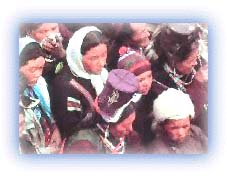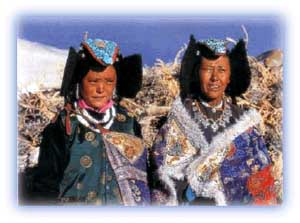Ladakh himalayas
General Info
· Villages
· Valleys and plateaus
· Lakes
· Passes
· Glaciers
· Rivers
· People
Ladakhis
· Shia Muslims of Kargil
· Occupations
· Gujjars
· Brokpas
· Tradition and Culture
· Livelihood
· Baltis
· Livelihood
· Religion, tradition, culture
· Changpas
· Livelihood
· Tradition and Culture
· Religion
· Fairs and festivals
· Other places of interest

![]()
| Ladakhis - page 2 Also read the previous page Many significant dynamic changes have taken place in Ladakh since the Chinese occupation of Tibet as a consequence of which their traditional trade with Central Asia and Tibet suffered. The war with China in 1962 brought a complete halt to this trade as China illegally occupied some parts of Ladakh. The war with China also brought about many other changes in Ladakh, which ultimately had an effect on the lives of the Ladakhis. |
 |
| Ladakhis Credit: KOA |
The general pattern of the lives of the Ladakhis is influenced to a large extent by the harsh climatic conditions. Each village is a self-sufficient unit -- this is especially true in the case of far-flung areas where communication and accessibility still remain a major constraint. Due to the low population density and harsh environment a considerable part of the agricultural operations have to be carried out in the form of community activities at the village level or by the coming together of the people of a number of villages. This has led to the formation of a closely-knit society.
 |
| Ladakhi women in traditional finery. Credit: Discover India magazine |
The traditional Ladakhi society was divided into the rgyal-rigs or the royalty. They were followed by the sku-drag or the nobles. The dmans-rigs or the peasants and the rig-nan or the outcasts completed the hierarchy.
Traditional social and administrative positions in the Ladakhi society in the past included those of the king or rgyal po, the lords or jo, the provincial or regional governor or bka-bhan, the village headman or goba and the master of the castle or mkhar-dpon.
This hierarchy used to be followed strictly in the past. But now it broken down considerably, particularly in the last two decades, which have seen considerable changes in the traditional way of life of the Ladakhis.
Livelihood
The Ladakhis depend, to a large extent, on agriculture and
animal husbandry for their livelihood. However, in the recent
past, other subsidiary occupations have also been adopted by
them. These include employment with the government (either as
daily wage laborers or in the form of regular service),
business (mainly shopkeeping and hotel-keeping) and service in
the army.
All rights reserved